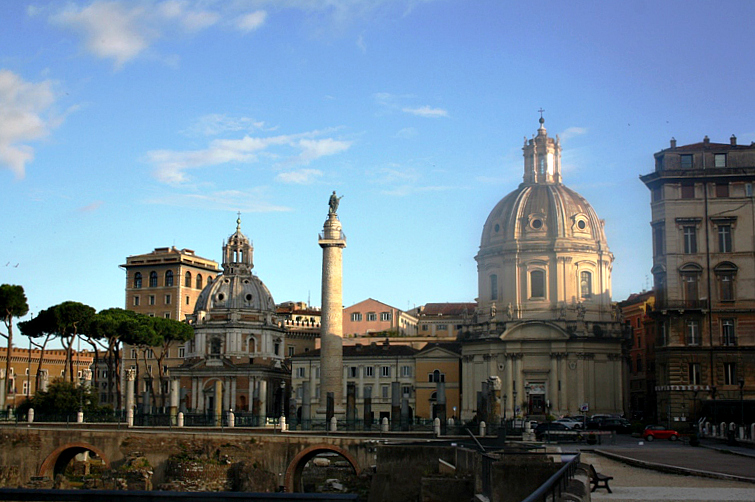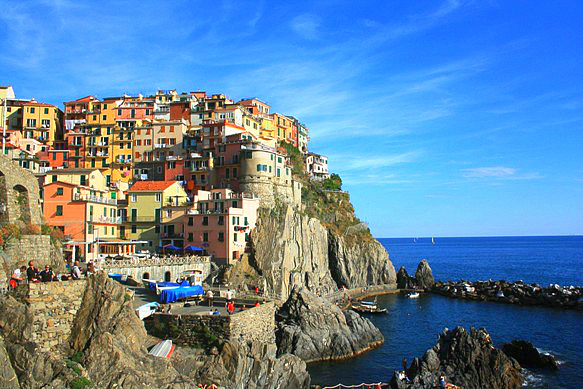
Bev had long planned to row the 40th Vogalonga in Venice to celebrate her passing into old age and Rita wanted to experience her heritage - born in Oz but never having been to Italy, although she is fluent in the language. We had been before, but the destinations of Amalfi and the Cinque Terre were new to us all and more than justified a return.
Rome
Bucket List Rating 




- More Rome photos
 >Colusseum
>Colusseum The Pantheon, commissioned sometime after 27BC and in great nick for its age
The Pantheon, commissioned sometime after 27BC and in great nick for its age Typically deserted street in the morning
Typically deserted street in the morning Roman-era ruins behind the Victor Emmanuelle monument
Roman-era ruins behind the Victor Emmanuelle monument Memorial to Victor Emmanuelle, the father of a unified Italy
Memorial to Victor Emmanuelle, the father of a unified Italy Much of the exterior of the Colusseum is in remarkably good shape
Much of the exterior of the Colusseum is in remarkably good shape What a shame security grids are needed. Judging by the graffiti in Rome it's likely wise
What a shame security grids are needed. Judging by the graffiti in Rome it's likely wise It's not a big stretch to imagine gladiators, christians and lions
It's not a big stretch to imagine gladiators, christians and lions Access to the cheap seats
Access to the cheap seats Castel Sant Angelo from Ponto Vittorio Emmanuele II
Castel Sant Angelo from Ponto Vittorio Emmanuele II Dome of St Peters from the Tiber
Dome of St Peters from the Tiber Dome of St Peters from the museum grounds
Dome of St Peters from the museum grounds Vatican museum
Vatican museum Vatican museum
Vatican museum Vatican museum
Vatican museum St Peters from the piazza
St Peters from the piazza This building surrounded a small courtyard
This building surrounded a small courtyard There's no-one around in the mornings
There's no-one around in the mornings A computer screen spoils the illusion of Renaissance Rome
A computer screen spoils the illusion of Renaissance Rome The ornate front of the Victor Emmanuelle memorial
The ornate front of the Victor Emmanuelle memorial Trevi Fountain. On our 1st visit there were shoulder-to-shoulder crowds. This time, there were only a few other tourists
Trevi Fountain. On our 1st visit there were shoulder-to-shoulder crowds. This time, there were only a few other tourists Victor Emmanuelle memorial from the Colonna Palace Hotel roof
Victor Emmanuelle memorial from the Colonna Palace Hotel roof
Head Office of the Roman Empire and justification for a visit by the Roamin' Ruins and for that terrible pun. Rome neatly book-ends Istanbul as the capital of the Byzantine Roman empire and wraps up nicely all our other ancient Roman destinations in Greece, Turkey, Syria, Jordan and Croatia.
- WTF experience. The Ossuary of the Capuchin Friars on the Via Veneto. How to decorate with dead people parts - who thought this was a good idea? Apparently it's popular - but why? It's morbid and bizarre - the skeletal remains of 3,700 friars, some posed in robes amongst stacked skulls and leg and arm bones with walls and ceilings decorated with other parts. "No photos allowed". No worries, I don't fekkin' want any.
- Rome is easy to navigate on foot, particularly early in the day until about 9:00 as there is no-one around. After that it gets crowded but morning rambles to take photos were pretty much uninterrupted.
- Location, location, location. Stay in central Rome, not outside it. Perhaps not the cheapest option but the total lack of phaffing about to get in and out more than compensates for higher hotel rates. The plentiful, and in our experience universally good cafes and restaraunts provide a plethora of choice for victuals and a stroll in any direction will find no lack of options. The Colonna Palace Hotel at Piazza di Monte Citorio is Rome Central - everything is accessible by foot or, if feeling lazy, by hop-on-hop-off buses.
- Alfresco dining. Why sit indoors when you can watch the passing parade? The spruikers at a lot of restaurants can be good natured and entertaining in their attempts to get the punters in. And it's amazing what you can negotiate when there are 6 of you.
- Vatican City and the Vatican Museum.
The crowds to get into the Vatican Museum can be horrendous with 2 hour waits being the norm.
Hire a guide and jump the queues - there is no avoiding the jammed crowds inside.
The Sistine Chapel was, to be frank, a disappointment. Not the frescos or Michelangelo's ceiling but expectations are built up, and in amongst the claustrophobic crowds in the surpisingly not very big chapel, they are then let down a bit.
The shuffling hordes are constantly admonished via loudspeaker with "Silencio....shhhhhhhh" which kinda defeats the purpose. I pulled the plug and exited at this point.
Trivia: (The) Vatican is the smallest country in the world at less than half a square kilometre. It's not only surrounded entirely by another country it is also surrounded entirely by a city. San Marino, the fifth smallest country, is also entirely surrounded by Italy.
The Amalfi Coast
Bucket List Rating 





- More Amalfi Coast photos
 Punta Carena lighthouse, Capri
Punta Carena lighthouse, Capri Amalfi
Amalfi Amalfi coastline
Amalfi coastline Amalfi coastline
Amalfi coastline Amalfi
Amalfi Amalfi
Amalfi Old fortresses and battlements (circa 1500s) spread along the coast
Old fortresses and battlements (circa 1500s) spread along the coast Random island
Random island Capri
Capri Capri
Capri Capri
Capri Capri
Capri Capri
Capri >Hurculaneum
>Hurculaneum >Hurculaneum
>Hurculaneum >Hurculaneum
>Hurculaneum >Pompeii
>Pompeii >Vesuvius from Pompei.
>Vesuvius from Pompei. >Pompeii
>Pompeii >Positano
>Positano >Positano
>Positano >Ravello
>Ravello >Sorrento
>Sorrento >Sorrento. Looking down from the Hotel Minerva.
>Sorrento. Looking down from the Hotel Minerva. >Marina della lobra near Sorrento
>Marina della lobra near Sorrento
While not strictly accurate I'll use Amalfi Coast to cover Amalfi, Positano, Ravello, Capri, Sorrento, Pompeii and Hurculaneum, all of which are wonderfully picturesque and fit nicely into the stereotypical Italy and are must-sees. Except for nearby Naples - once glamorous, now dirty, seedy and controlled by the Mafia, who quite obviously have not mastered the niceties of the tourism business. Apart from its hosting of the train terminal there is no reason to go there. Vesuvius would do Italy a favour if it blew again and buried the place - provided it spared next-door Hurculaneum which it covered in volcanic mud the first time and which is well worth an explore, being in even better condition than Pompeii which was smothered in ash rather than mud, the weight of which collapsed its buildings.
Sorrento is an ideal base from which to visit the other locations. It's central, it's large enough to cope with the milling throngs of tourists that can overwhelm the smaller towns like Positano and Amalfi and it has plentiful classy amenities, amongst which is the Hotel Minerva high on the headland with spectacualr views across the Bay of Naples to Naples itself which is far enough away to just look like pretty lights, and to Pompeii and Mt Vesuvius. The terraced hotel has large, sea-facing open areas, with our rooms having dedicated partitioned balconies on which to relax and take in the view. Highly recommended by The Ruins.
Sorrento is an easy half-hour stroll from the Hotel. Capri, Amalfi and Positano are readily accessible by boat with the rugged coast making the trip worthwhile on its own. A road alternative by Ducati or Ferrari would be a treat - the windy road high up the mountain side would be a riders/drivers heaven. We jumped aboard a small tour boat at the Marina della lobra, a short bus ride away.
Positano, Amalfi and Ravello are lovely but the tourist multitudes can make them claustrophobic. Regular buses from Amalfi make it easy to visit Ravello high up on the mountain via multiple hairpin bends and you'd be nuts not to head up, take in the scenery and have a poke around - it's a nice little village with a main piazza, galleries and cafes.
Cinque Terre
Bucket List Rating 





The Five Lands of Liguria in north-western Italy with their villages of Monterosso al Mare, Vernazza, Corniglia, Manarola, and Riomaggiore spread almost eqi-distantly long the rugged coast of steep hills - very similar to the Amalfi coastline. Each is connected by rail, road, ferries and hiking trails that are a big attraction as became apparent from the large number of walkers kitted out in the full-on hiking regalia. A bit over the top if you ask me. It may be up hill and down dale but it aint Mt Everest when you can stop for a cappucino or a cianti at any of the villages.
The confronting crowds upon our arrival at Manarola had largely dissipated by the following day thank god. Manorola is small. It has one main narrow thoroughfare with a few steep, side alleyways with story-book apartment buildings clustered around it on the hillsides.
The five villages all have their charms, as does nearby Porto Venere:
- Monterosso at the western end is the largest with a far less claustrophobic feel. Intersected by a headland, it has two waterfront esplanades fronting piazzas and intriguing back streets that just must be explored. Apart from service vehicles it's mostly pedestrian traffic in the villages - these places weren't built for vehicular traffic. Road access between them is high on the hillside.
- Vernazza. A small cove in the steep coast forms a tiny harbour surrounded by apartments on the surrounding hills Vernazza was once a fortification protecting the inhabitants from maruading pirates.
- Corniglia, unlike the others, is built high on a promitory. It looked typically Italian-charming from the water but we didn't get an on-the-ground look at it.
- Manarola was our choice for staying over and we weren't disappointed. As small as it is it is easy to venture out to the other villages and to Porto Venere by the regular ferry service. Manarola has plentiful options to indulge in the local cuisine and vinos, all of the typical Italian standard - tasty and fresh.
- Riomaggiore has its beach touted as a primary attraction. "Beach" is a vast overstatement - it's wet dirt and gravel. The village is squeezed up a steep valley and while it looks the part it's a bit too squeezy to feel comfortable.
- Porto Venere, while not one of the 5 villages of the Cinque Terre is an easy ferry or train ride just further south and like the villages is a UNESCO World Heritage site, and its easy to see why. It's headland is dominated by the Church of St Peter and Doria Castle, it's rugged coastal cliffs are worth a tour boat ride to see up close and it looks to be an ideal base to explore the La Spezia region more widely.
Tuscany
Bucket List Rating 




Chianti country. We jumped a train for an implusive day-trip from Manarola. Despite the return journey being an equivalent distance to the width of the country it was easily undertaken. Italian trains are good and the country is narrow. Mostly lovely countryside from the train - stereotypical Italian villages and farmland with mountain backdrops. Saw none of the wilderness such as we later saw in Croatia - human habitation was obvious everywhere and grafitti was rampant at train stations but overall it's very pretty.

Florence
The gorgeous capital of Tuscany where you can readily imagine the place in the Renaissance. Visually Florence makes it obvious why Italy was the heart of European art and culture. Hisorically its residents have included Dante, Leonardo Da Vinci, Michelangelo, Botticelli, Donatello and the Medicis.
To look across the city from the surrounding hills is to time-travel. Large, vintage Italianate villas with big, landscaped gardens look across a city-scape that must not have changed much for hundreds of years and is dominated by the majestic dome of the 15th century Duomo.
The view from the hills obscures the Mussolini-era train station with it's fascist history and appearance (and the even worse MacDonalds opposite). The station is efficient but it looks like a boil on Sophia Loren's bum.
Pisa
The Leaning Tower could be dismissed as a tourist cliché but if you're on a train passing through Pisa you'd be mad not to hop off and have a look. It is well worth it despite the tourist hordes, most posing for photos as if they are propping it up, making the grounds appear as one large, uncoordinated tai-chi session.
The Tower is the campanille (bell tower) for the adjacent duomo (cathedral), itself quite impressive. Pisa seems like a story-book, mid-millenium looking town straddling the River Arno. We just shunted through from the station by taxi. Probably worth having an on-foot explore if you are not in a hurry. We weren't in a hurry, we're just old and easily tired
Venice
Bucket List Rating 





- More Venice photos
 San Giorgio Maggiore
San Giorgio Maggiore Bellissimo!
Bellissimo! Grand Canal near the Ponto Realto
Grand Canal near the Ponto Realto An evening stroll along deserted alleyways. In Venice!
An evening stroll along deserted alleyways. In Venice! Lots of canals, lots of bridges (409)
Lots of canals, lots of bridges (409) Early morning, pre-tourists
Early morning, pre-tourists It can be fun getting lost, and a challenge to find your way back
It can be fun getting lost, and a challenge to find your way back Noice!
Noice! Access to the tradesmens entrance
Access to the tradesmens entrance Canals, bridges, alleys and piazzas
Canals, bridges, alleys and piazzas Its a-maze-ing
Its a-maze-ing Ponto Rialto
Ponto Rialto Ponto Rialto
Ponto Rialto San Marco
San Marco Somewhere in the Cannaregio district. Photo: Chris
Somewhere in the Cannaregio district. Photo: Chris A gondolier and the Ponto Rialto. How Venice!
A gondolier and the Ponto Rialto. How Venice! Getting ready for the day. San Marco early a.m.
Getting ready for the day. San Marco early a.m. Lost in Venice
Lost in Venice Burano
Burano Burano
Burano
Venice is one of those places that lives up to every expectation. Any introduction to the place should be by water taxi down the Grand Canal. You don't just look at Venice, you absorb it as you motor past the grand, decaying edifices and towers with the canal lapping at their foundations, the bustle of gondolas and vaporettos, the labyrinthine side canals and scattrered piazzas to explore on foot through the maze that makes up Venice.
Truly stunning, but truly exasperating when the big cruise ships unload. Those things disgorge their cargos by the tens of thousands who then clog the place up and proceed to filthy the place up too. Venice is swept clean every morning and the time to get out and about is the morning; pre-crowds and while the place still looks and feels fresh. Once the crowds hit, it's time to visit the islands like Murano and Burano or head off down the alleyways to get lost and explore.
Our chosen stop-over was the Hotel Rialto at the foot of the Ponto Rialto. This is the eye of the storm when it comes to crowds in looney numbers - it's on the Grand Canal, it's next to the iconic bridge of the same name and it's the cross-over point between the two halves of the city. By god, could those crowd numbers get mental! So why stay there? The pluses outnumber the minuses:
- It's right on the Grand Canal with a (smallish) rooftop terrace with a great view of the Canal and Ponto Rialto.
- It's central to everything and therefore the best spot from which to venture out to explore.
- It's old and a bit tattered, so it's authentic.
A must-do in Venice is to lose yourself in the maze of back alleys and piazzas. Take a map though because you can easily end up walking in circles. There's something to see down every alley and canal. Despite the claims of Venice Of The East (Bangkok) and Little Venice (Mykonos) there's nothing that could come close to the real thing.
Travel notes
- Nut-job scooter riders. Scooters far outnumber proper motorbikes and even cars. It seems everyone in Italy has a scooter which likely explains the laid-back attitude that drivers have for the brave yet mad manouvres of the scooter pilots. Nothing is a barrier to overtaking on a scooter. Oncoming scooters, oncoming cars, oncoming buses and trucks, oncoming overtaking scooters - it seems it is expected and accepted and possibly explains why Italians are so prominant in world motorcycle racing.
- 300 kph trains. The train from Rome to Naples touched the triple ton all the while staying smooth and quiet. Although our train must've hit something on the way as upon arrival in Naples there was some concerned examination of the front of the train by staff. Whatever it was, we didn't feel a thing.
- All of the train services we tried in Italy were very good - fast, clean and efficient, but they can get crowded if you catch a busy line. Book your seats. And then don't be surpised to see someone sitting in them. A no-nonsense attitude to that solved the problem pretty easily.
- Scams. We experienced little in the way of scams and attempted rip-offs. Here's the few we did:
The Help You With Your Luggage scam. Unasked someone will help haul your luggage onto the train at the larger stations and then expect payment. Tell them bluntly to fuck off cos they are persistant buggers.
The Help You With The Indicator scam at those same railway stations where any advice to assist with your platform information comes at a price.
The Free Rose scam at the popular tourist attractions where you're invited to "take a rose, it's free". I saw through that but it cost Chris €7.
Pickpockets. A sign at Manarola station warned of their prescence. That station now needs a sign warning the pickpockets about Rita after she attacked one mid-dip on Lyn's backpack.

























 >
>











